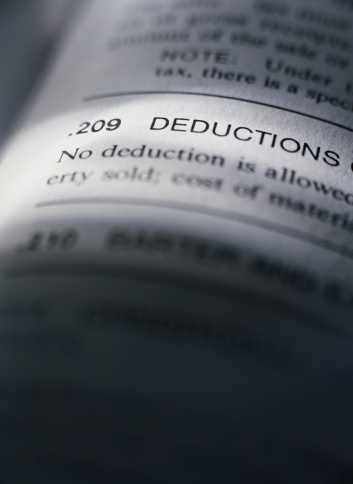 It’s 2020! Let’s take a quick look at some recent tax law changes affecting commercial real estate tax deduction restrictions. Below please find some insight into recent tax changes affecting commercial real estate tax deductions.
It’s 2020! Let’s take a quick look at some recent tax law changes affecting commercial real estate tax deduction restrictions. Below please find some insight into recent tax changes affecting commercial real estate tax deductions.
Here are some items that come to mind:
(1) The Tax Cuts and Jobs Act enables investment real estate owners to still defer capital gains taxes using section 1031 like-kind exchanges. There were no new restrictions on 1031 exchanges of real property made in the law. However, the new law repeals 1031 exchanges for all other types of property that are not real property. This means like-kind exchanges of personal property will no longer be allowed after 2017 for collectibles, franchise rights, heavy equipment and machinery, collectibles, rental vehicles, trucks, etc. The rules apply to real property not generally held for resale (such as lots held by a developer).
(2) The capital gain tax rates stayed the same so a real estate owner selling an investment property can potentially owe up to four different taxes: (1) Deprecation recapture at 25% (2) federal capital gain taxed at either 20% or 15% depending on taxable income (3) 3.8% net investment income tax (“NIIT”) when applicable and (4) the applicable state and local tax rate.
(3) The tax law creates a new tax deduction of 20% for pass-through businesses. This gets tricky but here goes. For tax years 2018-2025, an individual generally may deduct 20% of qualified business income from a partnership, S corporation, or sole proprietorship. The 20% deduction is not allowed in computing Adjusted Gross Income (AGI), but is allowed as a deduction reducing taxable income.
Restrictions on Tax Deductions
(1) Mostly, the deduction cannot exceed 50% of your share of the W-2 wages paid by the business. The limitation
can be computed as 25% of your share of the W-2 wages paid by the business, plus 2.5% of the unadjusted basis
(the original purchase price) of property used in the production of income.
(2) The W-2 limitations do not apply if you earn less than $157,500 (if single; $315,000 if married filing jointly).
(3) Certain personal service businesses are not eligible for the deduction, unless their taxable income is less than
$157,500 for singles and $315,000 if married. A “specified service trade or business” means any trade or business involving the performance of services in the fields of health, law, consulting, athletics, financial services, brokerage services, or any trade or business where the principal asset of such trade or business is the reputation or skill of one or more of its employees or owners, or which involves the performance of services that consist of investing and investment management trading, or dealing in securities, partnership interests, or commodities. (It appears President Trump liked real estate people but did not like professionals like lawyers, doctors, accountants and other consultants).
(4) The exception to the W-2 limit and the general disallowance of the deduction to personal service businesses is phased out over a range of $50,000 of income for single taxpayers and $100,000 for married taxpayers filing
jointly. By the time income for a single taxpayer reaches $207,500 or $415,000 for a married-filing-jointly
taxpayer, the W-2 limitation will apply in full (i.e. personal service professionals get no deduction).
(5) The new tax law increased the maximum amount a taxpayer may expense under Section. 179 to $1,000,000 and increased the phaseout threshold to $2,500,000. Interestingly, the new law also expanded the definition of Section. 179 properties to include certain depreciable tangible personal property used predominantly to furnish lodging. It also expanded the definition of qualified real property eligible for Section 179 expensing to include the following improvements to nonresidential real property: roofs; heating, ventilation, and air-conditioning property; fire protection and alarm systems; and security systems
(6) State and local taxes paid regarding carrying on a trade or business, or in an activity related to the production of income, continue to remain deductible. A rental property owner can deduct property taxes associated with a business asset, such as any rental properties. Don’t confuse such with the itemized deduction for your personal residence or vacation home which is now limited.
(7) While the prior law generally allows a deduction for business interest expenses, the new tax act limits that deduction to the business interest income plus 30% of adjusted taxable income. However, taxpayers (other than tax shelters) with average annual gross receipts for the prior three years of $25 million or less are exempt from this limitation. Real estate businesses can elect out of the business interest deduction limitation, but at the cost of longer depreciation recovery periods—30 years for residential real property and 40 years for nonresidential real property. If a real estate business does not elect out of the interest deduction limitation, then residential and nonresidential real property depreciation recovery periods are maintained at 27.5 years and 39 years, respectively.
Phew-there you have taste of what we’re going or at least as we see general changes directly or even indirectly
affecting real estate peeps. As you can see, the new law will bring a lot of changes (both good and bad) to individual and business taxpayers. On the plus side, this means more planning opportunities for many although looking for answers can be problematic as we all try to navigate through uncertain territory. These comments only touch the surface of one of the biggest tax overhauls in the nation’s history. Stay tuned and do stay close to your tax attorney and accountant.….



